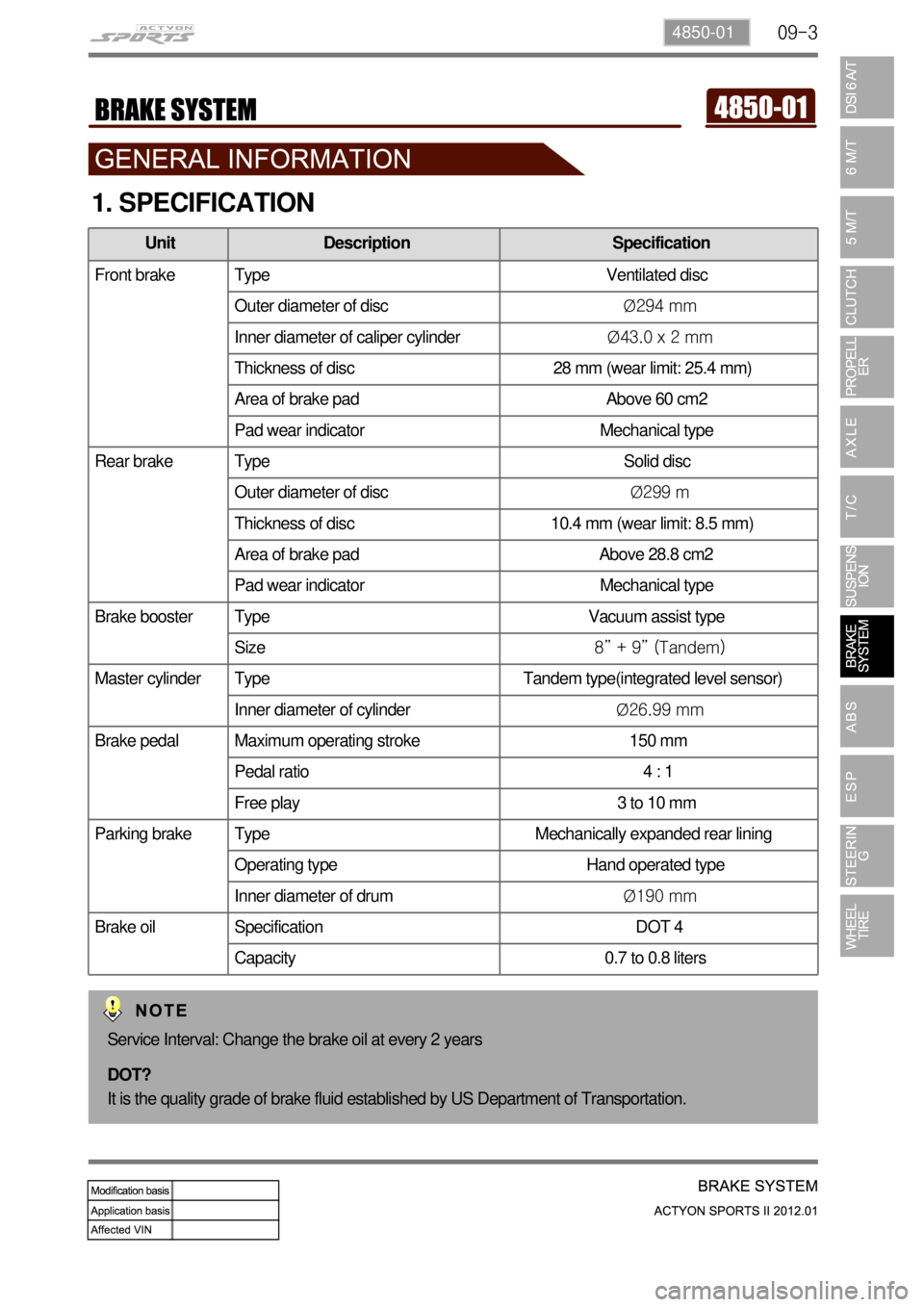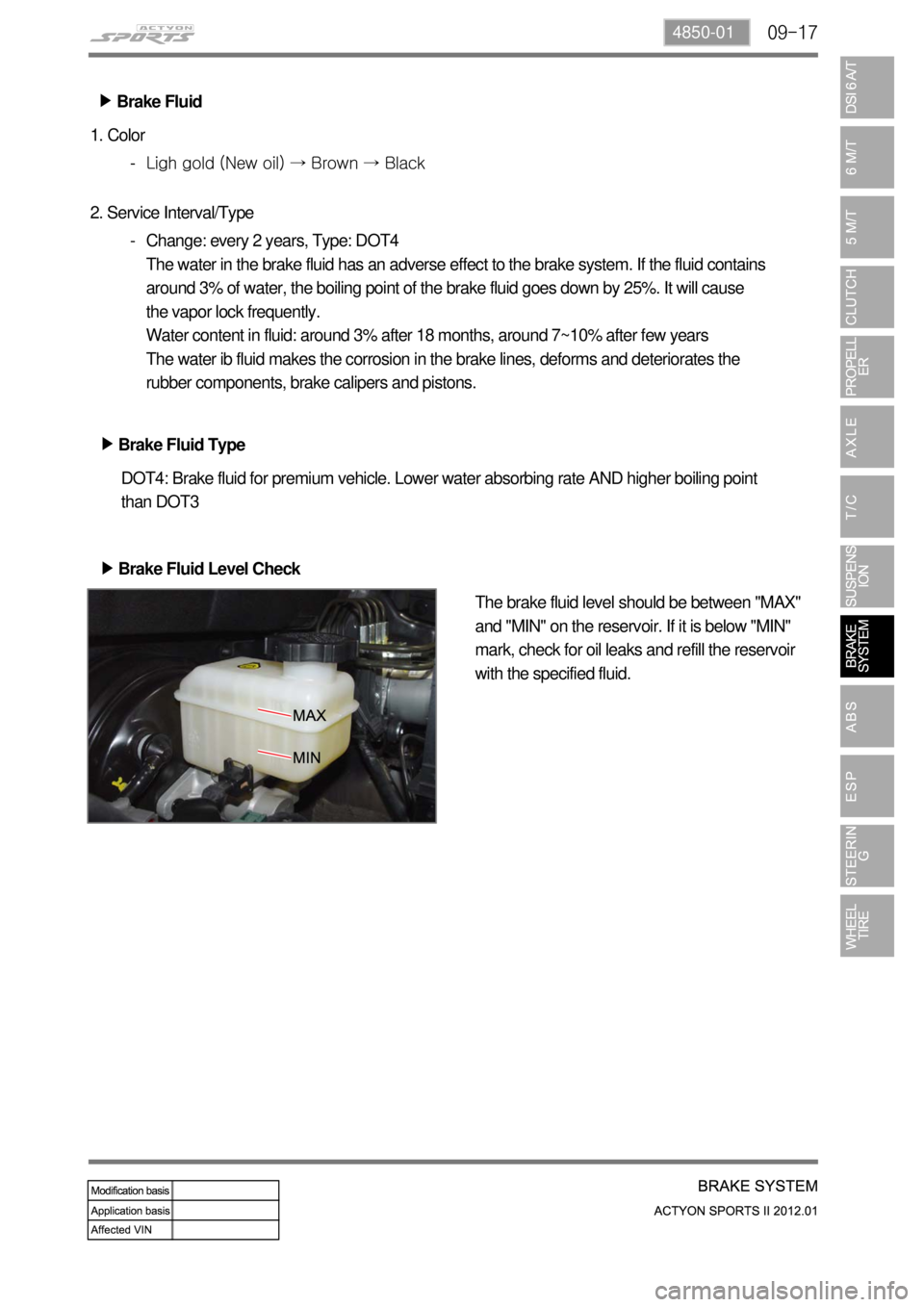service SSANGYONG NEW ACTYON SPORTS 2012 Owner's Guide
[x] Cancel search | Manufacturer: SSANGYONG, Model Year: 2012, Model line: NEW ACTYON SPORTS, Model: SSANGYONG NEW ACTYON SPORTS 2012Pages: 828, PDF Size: 91.28 MB
Page 646 of 828

08-10
2. FRONT SUSPENSION (DOUBLE WISHBONE)
Advantage ▶
The advantage of a double wishbone suspension is that it is fairly easy to work out the effect
of moving each joint, so the kinematics of the suspension can be tuned easily and wheel
motion can be optimized.
It is also easy to work out the loads that different parts will be subjected to which allows more
optimized lightweight parts to be designed.
They also provide increasing negative camber gain all the way to full jounce travel unlike the
MacPherson strut which provides negative camber gain only at the beginning of jounce travel
and then reverses into positive camber gain at high jounce amounts. 1.
2.
3.
Disadvantage ▶
The disadvantage is that it is slightly more complex than other systems like a MacPherson strut.
Due to the increased number of components within the suspension setup it takes much longer to
service and is heavier than an equivalent MacPherson design. 1.
2. Double wishbone suspension is an independent suspension design using two (occasionally parallel)
wishbone-shaped arms to locate the wheel. Each wishbone or arm has two mounting points to the
chassis and one joint at the knuckle. The shock absorber and coil spring mount to the wishbones to
control vertical movement. Double wishbone designs allow the engineer to carefully control the
motion of the wheel throughout suspension travel, controlling such parameters as camber angle,
caster angle, toe pattern, roll center height, scrub radius, scuff and more.
Lower arm Upper arm Shock absorber Stabilizer
Page 651 of 828

09-34850-01
1. SPECIFICATION
Unit Description Specification
Front brake Type Ventilated disc
Outer diameter of discØ294 mm
Inner diameter of caliper cylinderØ43.0 x 2 mm
Thickness of disc 28 mm (wear limit: 25.4 mm)
Area of brake pad Above 60 cm2
Pad wear indicator Mechanical type
Rear brake Type Solid disc
Outer diameter of discØ299 m
Thickness of disc 10.4 mm (wear limit: 8.5 mm)
Area of brake pad Above 28.8 cm2
Pad wear indicator Mechanical type
Brake booster Type Vacuum assist type
Size8” + 9” (Tandem)
Master cylinder Type Tandem type(integrated level sensor)
Inner diameter of cylinderØ26.99 mm
Brake pedal Maximum operating stroke 150 mm
Pedal ratio 4 : 1
Free play 3 to 10 mm
Parking brake Type Mechanically expanded rear lining
Operating type Hand operated type
Inner diameter of drumØ190 mm
Brake oil Specification DOT 4
Capacity 0.7 to 0.8 liters
Service Interval: Change the brake oil at every 2 years
DOT?
It is the quality grade of brake fluid established by US Department of Transportation.
Page 665 of 828

09-174850-01
Brake Fluid ▶
Brake Fluid Type ▶ 1. Color
Ligh gold (New oil) → Brown → Black -
2. Service Interval/Type
Change: every 2 years, Type: DOT4
The water in the brake fluid has an adverse effect to the brake system. If the fluid contains
around 3% of water, the boiling point of the brake fluid goes down by 25%. It will cause
the vapor lock frequently.
Water content in fluid: around 3% after 18 months, around 7~10% after few years
The water ib fluid makes the corrosion in the brake lines, deforms and deteriorates the
rubber components, brake calipers and pistons. -
DOT4: Brake fluid for premium vehicle. Lower water absorbing rate AND higher boiling point
than DOT3
Brake Fluid Level Check ▶
The brake fluid level should be between "MAX"
and "MIN" on the reservoir. If it is below "MIN"
mark, check for oil leaks and refill the reservoir
with the specified fluid.
Page 729 of 828

12-34610-01
1. SPECIFICATIONS
Description Specification
Steering wheel Type 4-spoke type
Gear box Type Rack and pinion type
Gear ratio 40.245
Steering angle Inner37.59˚
Outer33.48˚
Oil pump Type Vane type
Maximum pressure (kgf/cm2)90 ± 3
Pulley size (mm)Ø115
Operating temperature-40℃~150℃
Minimum turning radius (m) 5.95
Steering oil Type ATF Dexron II or III
TOTAL FLUIDE DA
(Extreme cold condition only)
Capacity (L) Approx. 1.0
Service interval Daily check and add if necessary.
Page 739 of 828

12-134610-01
Oil Pump Pressure Check ▶
Unscrew the pressure line fitting in power
steering pump.
Install the pressure gauge between the
power steering pump and the power
steering oil pressure line.
Place the shift lever to neutral position.
Apply the parking brake.
Open the valve in pressure gauge. Start
the engine and let it run at idle speed.
Turn the steering wheel several times so
that the oil temperature reaches to normal
operating level. 1.
2.
3.
4.
5.
Before checking the pressure, check the oil
level and belt tension. Prepare the empty
container to collect the spilled oil during the
service. Check the oil pump pressure to locate any
defect in oil pump.
Fully close the valve in pressure gauge and
measure the oil pressure. 6.
Relief pressure
90 ± 3 bar
Oil pump
Steering gear box
To prevent internal damage, do not close
the gauge valve over 10 seconds.
Keep the oil temperature at proper range. -
-
Page 787 of 828

02-58810-01
3. GENERAL WARNINGS
Do not diagnose the circuit with a circuit tester or attempt to modify any air bag components
including the steering wheel, air bag mounting area and harness.
Incorrect inspection could cause a problem with an air bag and seat belt pretensioner, and
they cannot protect occupants properly. Inspection and repair service should be done only by
a qualified technician.
An infant or a child should not be seated on the front seat alone or on an adult's lap. An infant
or a child could be severely injured by air bag deployed.
A child restraint system should be placed on the rear seat which has the 3-point type seat belt.
Never install a child restraint system on the front seat. Impact by the air bag inflation might
cause severe injury or even death.
When an occupant fastens the seat belt with unstable or inclined posture, the air bag cannot
protect the occupant properly. Moreover, the occupant may be injured by the air bag.
Do not incline toward the steering wheel while driving. If you hit the air bag before it is fully
inflated, brain or neck injury, or even death can occur.
Be careful not to strike the steering wheel, air bag mounting area, any air bag related
component (including wiring) and seat belt pretensioner. You might get severely injured by
sudden deployment of the air bag.
The air bag contains explosive materials, so handle it carefully when disposing or replacing it.
The air bag components will be very hot immediately after deployment. Do not touch them until
they cool down.
Once the air bag/seat belt pretentioner is triggered, it will not deploy again even if an additional
impact is applied to it. Once triggered air bag/seat belt pretensioner related components
cannot be reused, so they should be removed from the vehicle and the whole system should
be replaced with a new one.
Do not place any object or sticker on the air bag mounting area for correct and safe activation
of the air bag.
Do not bang the door. Otherwise, an air bag might operate erroneously.
Hold the outer rim of the steering so that the air bag can inflate without any hindrance.
Do not incline toward the steering wheel or hold the steering wheel with your hands crossed. It
will cause a problem with the air bag activation or severe injury when the air bag inflates.
Never put your hands or feet on the dash board. You can severely injured when the air bag
inflates.
It is normal that a loud noise, dust and smoke occur when the air bag and seat belt
pretensioner operate.
The gas come out of air bag/seat belt pretensioner activation is non-toxic nitrogen gas.
However, if this gas occurs irritation to your skin, eyes, nose, and so on, wash it out with clean
water. Seek medical help if symptoms develop. -
-
-
-
-
-
-
-
-
-
-
-
-
-
-
-
-
-
-